2019
Livestock Management During Winter Weather
Fall is always a busy time of year and this fall is no exception. With finishing harvest, weaning, and bringing home feed from the field many of us are extremely busy. Following the early winter storm many of us are now working twice as hard trying to move snow, locate cattle that may have strayed in the storm, and possibly making decisions about feed resources that are now either buried in the snow or drifted in somewhere inaccessible for a period of time. There are options for alternative feed resources including by-products, screening, and other roughage sources to help bridge the possible feed supply gaps created by the recent weather. For a list of possible alternative feeds please visit go to the following linkhttps://www.ag.ndsu.edu/publications/livestock/alternative-feeds-for-ruminants.
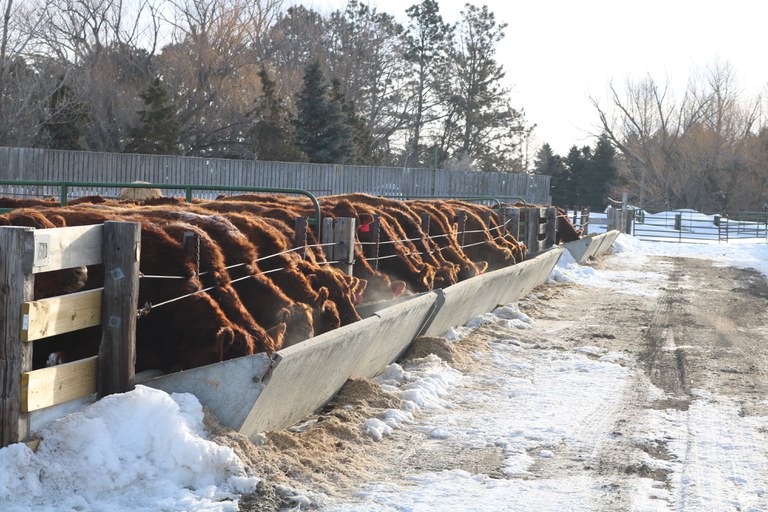
Cows at the CREC often have by-products, screening and alternative roughage sources in their diets.
Another important concept for winter management is improving pen conditions. With the wet summer and fall we had, many of us are struggling with deteriorating pen conditions. With the onset of winter, it is important for us to keep in mind the need for improving pen conditions and the environmental conditions for cattle as temperatures continue to decrease. Past research at the CREC has demonstrated that providing bedding can improve livestock gains during the winter months. Research from other universities has also demonstrated that pen conditions can lead to effects on livestock performance and economic returns. For more information about winter management of feedlot cattle visit the following link https://www.ag.ndsu.edu/publications/livestock/winter-management-of-feedlot-cattle.
For those of you affected by the recent snow storm, our thoughts are with you as you work to care for your livestock and conclude harvest.
Bryan W. Neville, Ph. D.
Bryan.Neville@ndsu.edu
Research Animal Scientist
Think Spring, Think Foundation Seed
October suggests it is time to begin preparing for the next growing season, even though the past few months of excess rain have presented many challenges of completing harvest of the current season’s crops. Beyond fall field work and fertilizer applications, current preparations may also include lining up seed for the 2020 season. With this in mind, I send this note to update you on the status of foundation grade seedstocks available at the Carrington Research Extension Center. We have been working on cleaning and conditioning our seedstocks since the middle of August. Our seedstocks program has again produced and harvested a diversity of crops and varieties that present options for the coming season. This fall’s wet weather during harvest may present a problem of finding good quality planting seed if you wait to order in the spring.
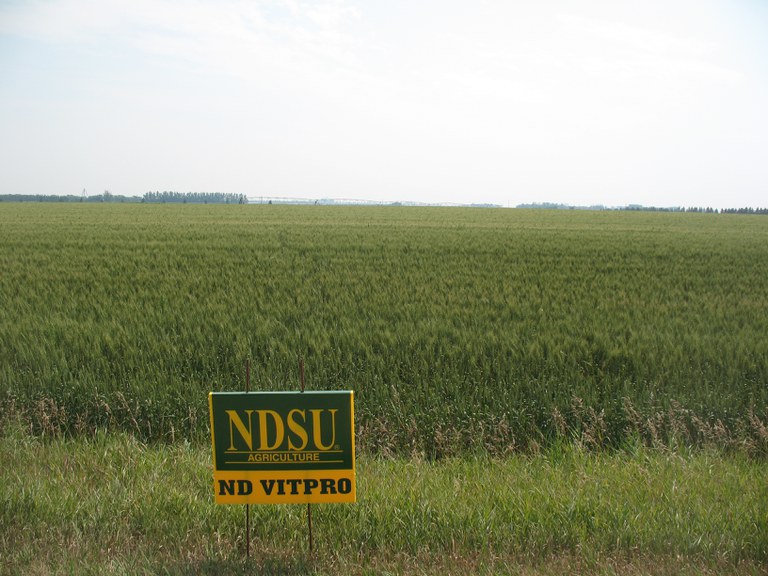
ND VitPro Hard Red Spring Wheat
Listed below are the foundation grade seedstocks varieties that the CREC has available in our inventory for spring 2020 seedstocks plantings.
Spring Wheat
- Faller
- Glenn
- Lang MN
- Shelly
- ND VitPro
- MN Washburn
Durum
- Carpio
- Divide
- ND Grano
- Joppa
- ND Riveland
Barley
- ND Genesis
- Pinnacle
Flax
- ND Hammond
- Omega
- York
Soybean
- ND Benson
- ND17009GT
- ND Rolette
- ND Stutsman
Buckwheat
- Manor
Winter Rye
- ND Dylan and ND Gardner
The CREC has three new varieties. Two from North Dakota and one from Minnesota that are publicly available after being distributed through the County Crop Improvement Associations. These include a wheat, a soybean and a winter rye. The varieties will be protected under Plant Variety Protection (PVP) Title V. They must be sold as a class of certified seed.
- MN Washburn (spring wheat) is a University of Minnesota release. The main features are excellent straw strength and a good overall disease package. It contains the bdv2 gene for resistance to the Barley Yellow Dwarf Virus (BYDV). Along with a consistent yield, it can provide excellent milling and baking qualities.
- ND Rolette (soybean) is an NDSU conventional line that has a 00.9 maturity with a high yield potential. It has been licensed to the North Dakota Crop Improvement and Seed Association for its management. ND Rolette is resistant to Race 4 of the Phytophthora Root Rot. It has a good level of tolerance to iron-deficiency chlorosis. ND Rolette has a purple flower color, grey pubescence, tan pod color and buff hila.
- ND Gardner (winter rye) is a very early and tall variety with very good winter hardiness and early season vigor. These are good attributes for the rapidly growing cover crop market. ND Gardner is superior to Aroostook in these comparing traits. It is about one day earlier in heading, has better winter hardiness and greater early season vigor. ND Gardner also has greater biomass production than Aroostook. Higher seed yields and better straw strength make ND Gardner a desirable replacement for Aroostook. ND Gardner is licensed to the North Dakota Crop Improvement and Seed Association for its management.
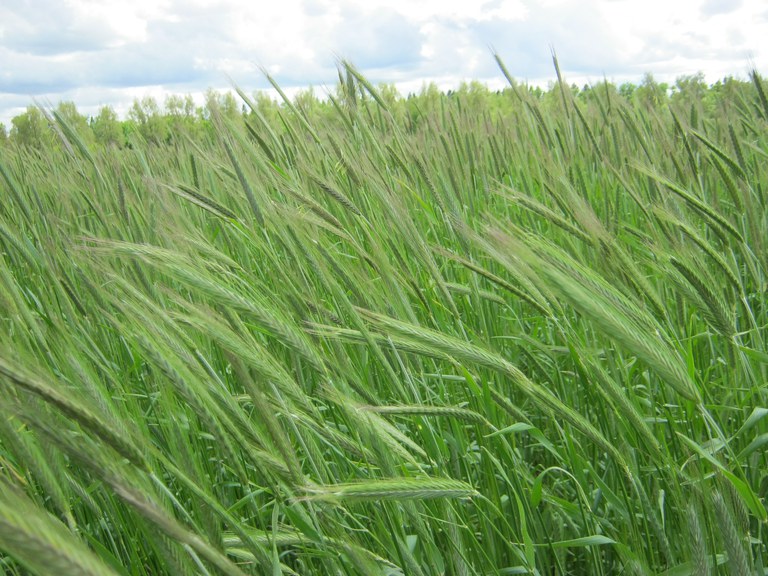
ND Gardner Winter Rye
If you are interested in any of these varieties, you can call the CREC at 701-652-2951, e-mail at myrna.friedt@ndsu.edu or call Dave Copenhaver at 701-652-5853.
Other cultivars and additional quantities may be available from other Research Extension Centers and the Agronomy Seed Farm. The NDSU Foundation Seedstocks Pricing Committee will set seed prices for this year’s seed soon and the prices will be published in the near future on the Foundation Seedstocks website: https://www.ag.ndsu.edu/fss/seed-prices. Within the NDSU Foundation Seedstocks program, seed orders received by December 1 will be given preference and priority when allocating foundation seed.
Dave Copenhaver
David.Copenhaver@ndsu.edu
Foundation Seedstocks Research Spec.
Dakota Feeder Calf Show Feedout
The 21st annual Dakota Feeder Calf Show is set for Saturday, October 19, in Turtle Lake, N.D.
Cattle will be accepted at the Turtle Lake weighing station before 10 a.m. on the day of the show and exhibited as groups of three or four head. Producers exhibiting calves at the show then have the option to send their calves to the North Dakota State University Carrington Research Extension Center's feedlot to be fed to market weight.
NDSU Extension is partnering with the Dakota Feeder Calf Show on the feedout project to provide producers with an opportunity to experience retaining ownership of cattle beyond the cow‐calf phase of production.
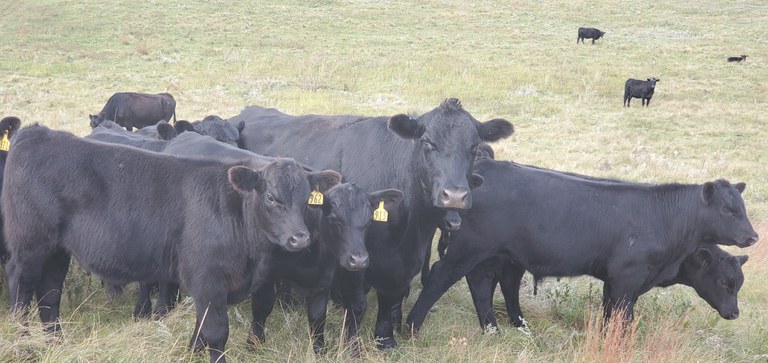 The feedout is an entry‐level way of learning about these options with three or four calves instead of the entire herd. Cattle producers have used the feeding and carcass information to select bulls that will improve the feedlot value of their calves.
The feedout is an entry‐level way of learning about these options with three or four calves instead of the entire herd. Cattle producers have used the feeding and carcass information to select bulls that will improve the feedlot value of their calves.
During the 2018‐19 feedout, the calves gained an average of 605 pounds in 212 days, with a total feeding cost (excluding interest) of 74.6 cents per pound of gain. The average sale weight was 1,325 pounds. The calves were fed with a market weight break‐even point of $115.87 per hundredweight.
In the 2018‐19 feedout, the spread in net return per head between the average of the top and bottom five herds was $169.47. The spread is more noticeable between the top and bottom herd - $366.69 per head. Weight gain per day of age was 3.52 pounds for the top‐profiting herd and 3 pounds for the bottom herd.
Feedout project staff will gather data on the rate of gain, feeding costs and other characteristics during the trial. After the calves are marketed, the staff will collect and provide information to the entrants on carcass weight, meat quality and value.
Producers will be assessed an entry fee of $20 per calf. Dakota Feeder Calf Show officials will present awards to producers at the end of the trial.
For more information or to preregister calves, contact Karl Hoppe at 701‐652‐2951 or karl.hoppe@ndsu.edu, or Darwin Chesrown, Turtle Lake Farmers Union Oil, at 701‐448‐2356.
Cattle may be registered the day of the show, but the feedout is limited to 160 head. Please register early.
Karl Hoppe, Ph. D.
Karl.Hoppe@nsdu.edu
Extension Livestock Specialist
Fall Weed Management Strategies
The calendar is turning to October, which means regular frost risks. But, before the spray equipment is put away for the winter, make sure you are satisfied with your weed management strategy. There is still time to prepare next season’s crops for a clean start. Here are two things to consider:
1: Perennial and winter annual weed management. Fall is the best time to control most perennial and winter annual weeds, including species like downy brome, Canada thistle, dandelion, and horseweed. Typical applications for these weeds include products like glyphosate and 2,4-D. Keep in mind, glyphosate-resistant horseweed is advancing very rapidly throughout North Dakota. With the amount of increased presence this season, I would expect that next season it will be an abundant weed in a large percentage of ND fields. Page 69 of the 2019 ND Weed Control Guide has product and application information specific to horseweed (and many other problem weeds). This is a weed that is going to be very challenging to control in-crop, but there are a number of options for fall or spring management. Horseweed is particularly challenging in reduced-till fields. October is often on the late side for these applications, but with the season we are having (no killing frost near Carrington yet), there are still opportunities to get a head start.
2: Residual herbicide application for row crops. The last few springs have had very challenging planting conditions resulting in narrow fieldwork windows. If residual herbicide applications are in danger of being missed in the spring due to planting constraints, you may want to consider a fall application. Products like flumioxazin and pyroxasulfone (ex. Valor, Fierce) have worked well with little drop in efficacy when applied in late October in Carrington. Other products like sulfentrazone (ex. Spartan, Authority) work but in our experience a fall application will require a higher rate than a person uses in the spring. These products’ strengths are some of the most troublesome weeds we deal with today. Kochia can be especially challenging in the spring since it may have emerged prior to any field work, and getting contact products into dense kochia leaf clusters may not be always be possible (figure 1). Using one or more of these chemistries will help reduce and/or delay the spring emergence of kochia and pigweed species in particular. Also, if you are growing a crop with limited herbicide options (lentils for instance, or if intercropping), fall herbicides can be a big advantage in your weed management success.
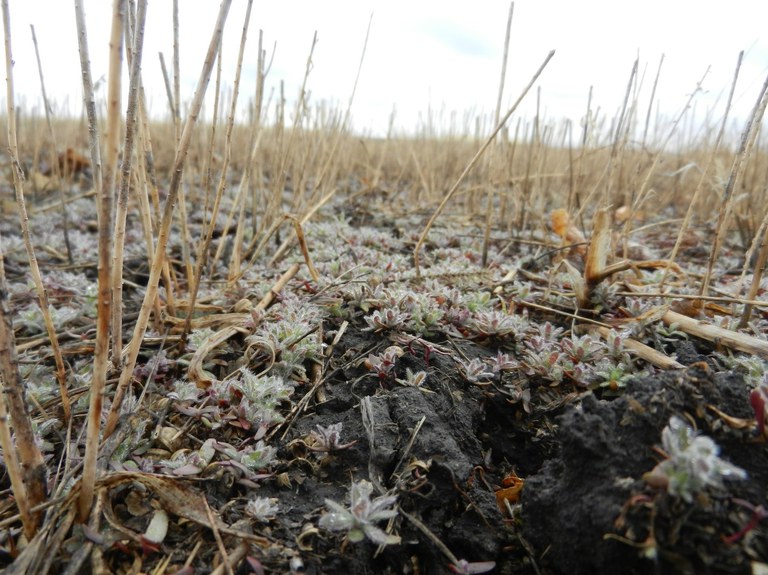 Figure 1. Kochia emergence on May 1 of 2014, prior to any field work that season.
Figure 1. Kochia emergence on May 1 of 2014, prior to any field work that season.
Mike Ostlie, Ph. D.
Mike.Ostlie@ndsu.edu
Research Agronomist
Small Grain Variety Trial Overview
Similar to recent farmer challenges with small grain harvest, the NDSU Carrington Research Extension Center (CREC) has struggled with harvest of early season crop research trials. However, we are harvesting again and currently have published 10 tables that contain data for small grain, field pea, and canola. The following is an overview of our 2019 dryland barley and spring wheat variety trial results.
The CREC’s barley variety trial tested 12 varieties plus experimental lines that were primarily 2-row types.
- The trial averaged
- 61.5 bu/acre
- 42.3 lb/bu test weight
- 83% plump
- 10.7% grain protein
- The trial’s plant lodging averaged 2 (scale: 0-9) with AAC Connect, CDC Bow, and CDC Fraser (2 row); and Lacey and Tradition (6 row) scoring 1, while Conlon (2 row) scored 7.
- Five out of nine varieties tested over the past three years had grain yield exceeding 90 bu/acre (90.2-96.9 bu/acre): AAC Synergy, ABI Balster, and Lowe (2-row); and Lacey and Tradition.

Barley variety trails at the CREC.
The CREC’s spring wheat variety trial tested 46 varieties plus experimental lines that averaged
- 47.4 bu/acre
- 59.6 lb/bu test weight
- 15,030 seeds/lb
- 15.3% grain protein.
- Nine out of 26 varieties tested over the past three years had grain yield exceeding 60 bu/acre (60.5-63.8 bu/acre): CP3504, CP3530, Faller, LCS Trigger, MS Chevelle, Prosper, Shelly, SY Valda, and TCG-Spitfire.
- Of these varieties, the following also averaged, over three years, > 14.0% protein (14.0-14.5%): CP3504, CP3530, Prosper, Shelly, SY Valda, and TCG-Spitfire.
- Varieties tested over the past three years that achieved 16% protein included Bolles, Linkert, and TCG-Climax.

HRSW variety trial harvest at the CREC.
Data tables for the barley and spring wheat plus eight other variety trials are currently available at the following website: www.ag.ndsu.edu/varietytrials/carrington-rec/2019-trial-results.
Greg Endres
Gregory.Endres@ndsu.edu
Extension Agronomist
Wheat Yield Response to Top-dress N Rates Estimated Using Crop Reflectance with a Remote Sensor
Introduction
Research has shown that yields can be improved by top-dressing wheat with N fertilizer, if the crop vigor (health status) can be estimated by some index and used to predict yields.
The NDVI (Normalized Difference Vegetation Index) is an index generated with remote sensors to assess crop vigor. It can be measured with the GreenSeeker sensor, for example, by collecting light reflected by the crop, and converting it to NDVI values. Higher values are indicative of a more vigorous crop, usually in response to N.
The objective of this research was to determine mid-season N need and rate to apply as top-dress using the NDVI data obtained with a handheld sensor and estimate the yield gained from top-dressing.
Research conducted in Carrington in 2019
Two wheat trials were established at Carrington under irrigation and dryland. Each trial received the same N treatments, which included five starter treatments (0, 40, 80, 120, 160 lbs N/ac) and two top-dress N rates based on the individual plot NDVI (0, 40 lbs N at planting, and additional N based on NDVI). The top-dress rates were determined from using several factors including NDVI, growing degree days, etc., to predict wheat yields.
Results
- Yields improved at higher N rates and began to decline above 120 lbs N. Protein data is not yet available.
- There was a strong relationship between NDVI and grain yields (Figure 1) at the irrigated site (R2= 81%), but not so good under dryland (R2 = 42%). This means that NDVI was a good predictor of yields under irrigation since it explained about 81% of the differences in yields but could explain only 42% of the yield differences observed at the dryland site.
- Similarly, the relationship between N rates and NDVI was weak under dryland (23%), and fairly good under irrigation (52%).
- Yields, however, improved from top-dressing with N rates (Table 1.). The top-dress N rates, estimated using NDVI data, are shown on table 1.
- Under irrigation, for plots without starter N, yields improved by 6.7 bushels from top-dressing with 40 lbs N. With 40 lbs applied as a starter, top-dress estimate was 22 lbs N, which improved yields by 2.6 bushels.
- Under dryland, for plots without starter N, yields improved by 6.3 bushels from top-dressing with 16 lbs N. When 40 lbs was applied as a starter, and top-dressed with 20 lbs N, yields improved by 3 bushels.
Observations
The remote sensor was useful in assessing crop vigor, which was used to predict yield, and determine variable mid-season N rates to apply and enhance yields.
Jasper Teboh, Ph. D.
Jasper.Teboh@ndsu.edu
Research Soil Scientist
Cover Crop Grazing
Cover crops offer the most immediate rewards to livestock producers since the forage can be grazed, offsetting the seed and planting expense. In 2019, the CREC initiated a large scale and comprehensive study to measure soil health, economic, and animal performance changes that occur with or without cattle grazing cover crops following cash crops. This study encompasses a wholistic approach to research with crops and livestock. The project is in the early stages of work, but already a lot has been done. For instance, baseline soil compaction measurements have been taken this spring using a combination of a handheld penetrometer and fuel efficiency data. Numerous soil samples have been taken this spring and already this fall to measure changes in nutrients and other soil properties. Cover crops have been planted in both wheat and corn for grazing later this fall. Fencing has also been put up on the wheat plots.
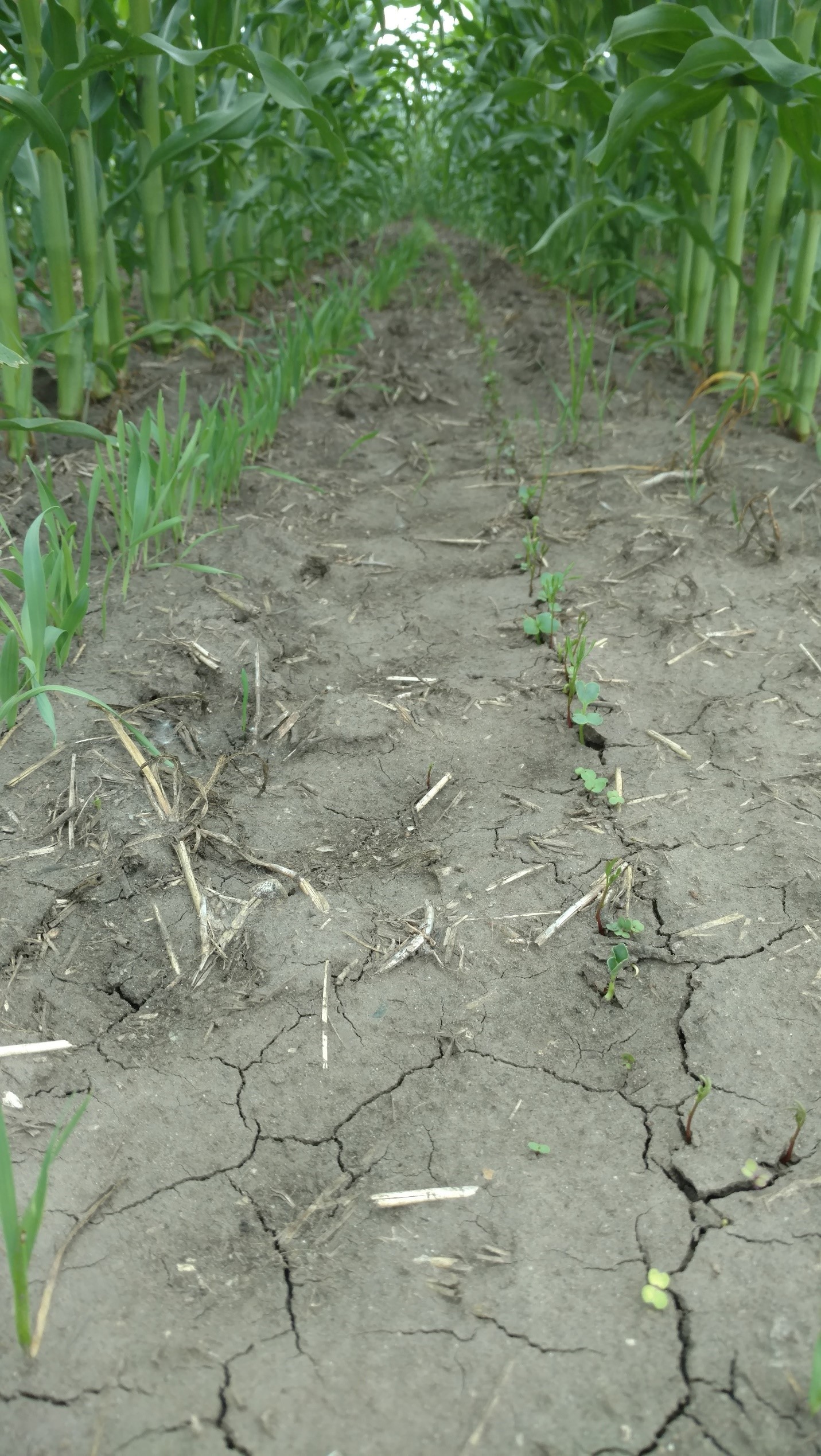
Brassicas and cereals seeded between corn rows on July 1 (pictured 2 weeks after planting).
On Tuesday, September 17th from 2-4 p.m., we will be hosting a workshop at the Carrington Research Extension Center to dive into the details of this study and cover the logistics of implementing cover crops in a livestock friendly manner. Some of the topics covered include equipment used to plant the cover crops, herbicide systems, crop selection, and livestock and fencing setup. This workshop is free of charge. We will start at the main office. Come join us for discussion and conversation with the research team!
Mike Ostlie, Ph. D.
Mike.Ostlie@ndsu.edu
Research Agronomist
The Fruit Fly Fight Continues
It’s been a busy and taxing summer in the fruit orchard. Busy is good: after a later spring, we had good berry crops and there are more apples, aronia, plums and grapes to come. Taxing was bad: a major number of spotted wing drosophila (SWD) fruit flies appeared and did their best to ruin the early fruit. The juneberries, cherries and late haskaps were all affected; currants to a much lesser degree.
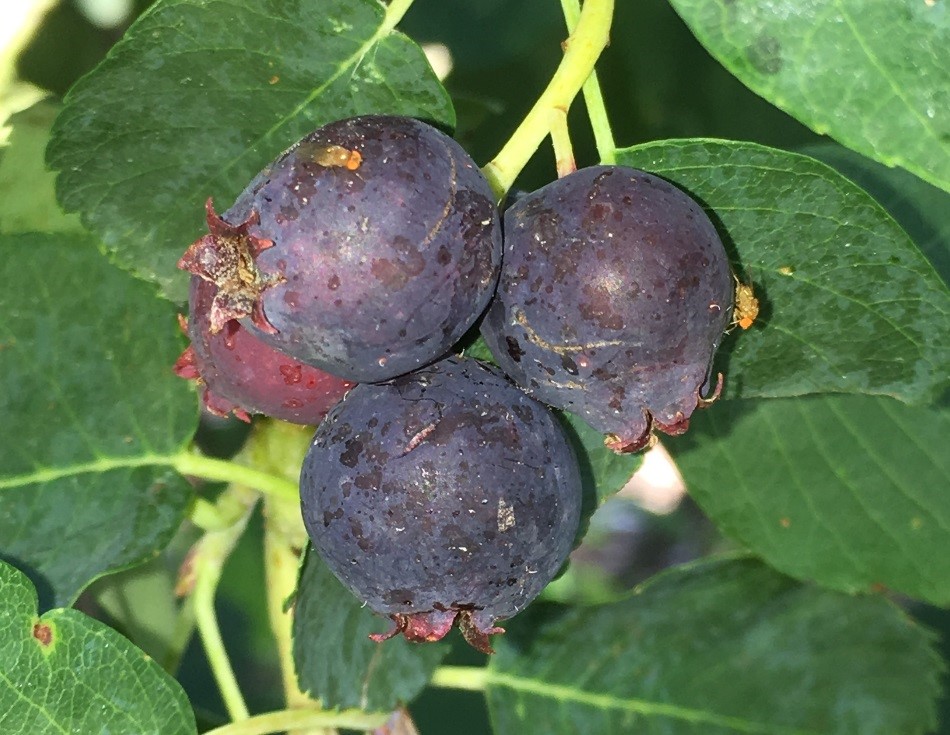 SWD fruit flies on Juneberry.
SWD fruit flies on Juneberry.
On July 7th, most of the juneberries were still red and I started spraying on the 9th and 10th, after it rained. It was moist and warm and the conditions were perfect for SWD. By Sunday, the 14th, the juneberries were swarmed with SWD. I called in emergency pickers plus our own crew and we did our best on Monday. The next day was Field Day and afterwards I allowed visitors to pick juneberries. We removed fruit the next 3 days and I sprayed the plants down again.
The cherry crop was a loss for about the seventh year. I held out hope for some trees and shrubs that I started spraying while the fruit was green but, alas, that fruit also succumbed.
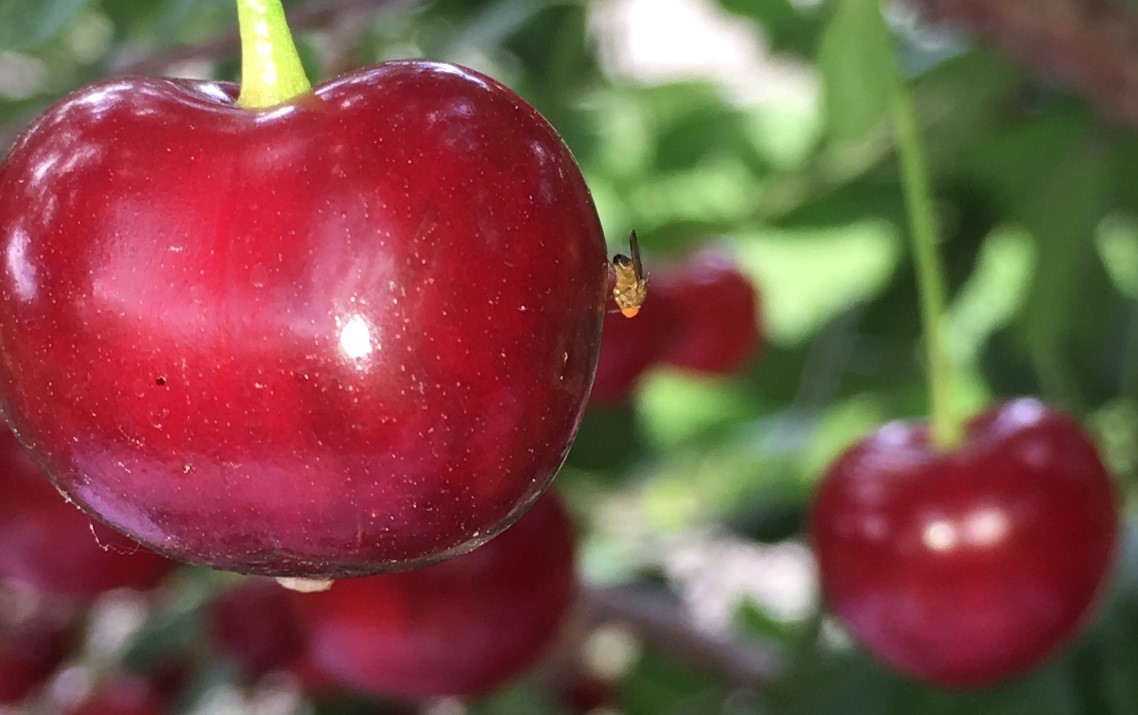 SWD fruit flies on sour cherry with a larva at the bottom of the fruit.
SWD fruit flies on sour cherry with a larva at the bottom of the fruit.
Early red and black currants were ruined though we don’t really find larvae in the fruit. I think they puncture the fruit and lay their eggs, but the egg rarely develops. The holes let in spoilage organisms and then the berry starts to dehydrate. We get a lot of dried/fermenting berries but don’t see any maggots. Later-ripening currants are generally less affected as SWD numbers go down with (normally) drier weather. And so far, I have never seen SWD in aronia berries.
So what can we do better? What can an average homeowner do? I have to say, spray-wise, I don’t know. Certainly CREC could get an air-blast sprayer that would get very fine droplets throughout the orchard (part of the problem is that I cannot spray the whole orchard in one evening with my handheld sprayer). SWD are known to hang out in woody edges and we have lots of those, too. So we could spray those areas or cut them down. But to what end? We need the wind protection and spraying only the plants has already eliminated the spiders and caterpillars I used to see during harvest. Too much insecticide will eventually bring on spider mites.
Netting? This is the only real solution to getting a crop with minimal insecticide use. Producers that are able to sell their crops to high-value markets, like restaurants, are doing this. I think this works for homeowners that have a small crop area to protect. The netting needs a structure and you will still have to scout for insects – just a couple getting inside will turn into thousands in no time. Because of the number of other projects at the CREC, I would not have the help needed to construct and maintain the structures, let alone deploy the netting. But a dedicated homeowner just might!
Possible netting source: https://www.berryprotectionsolutions.com/netting
Structure video: https://www.youtube.com/watch?v=_eAODdcYnXk
Kathy Wiederholt
Kathy.wiederholt@ndsu.edu
Fruit Project Manager
A Comparison of Three Garden Soil Test Kits and a Certified Soil Testing Lab
Introduction
Many garden retailers offer soil test kits. These kits offer fast results. However, the soil testing kits have not undergone the scrutiny that certified lab tests have.
Objective
Comparison of soil test results from three different soil test kits with a certified soil testing lab.
Methodology
Soil test results from the North Dakota State University Soil Testing Lab (NDSU STL), a certified commercial soil testing lab, were compared with the LaMotte1 complete soil test kit (LaMotte), Luster leaf rapitest soil test kit2 (Rapitest), and Luster leaf rapitest 4-way Analyzer3 (4-way Analyzer).
Fourteen different composite soil samples were collected from the top 6 inches from 14 locations in the north, south, east, west, and center of North Dakota. These 14 soils plus store-bought compost and potting soils were all tested. The soils were dried, ground, mixed, and each divided into six separate bags. Three bags were randomly selected and analyzed by the NDSU STL. The other soil bags were kept for garden soil test kit analysis.
Soil pH, nitrate, phosphorus (P), and potassium (K) levels were determined following instructions by the individual soil test kits (Figure 1) and compared to the NDSU STL results (Table 1).
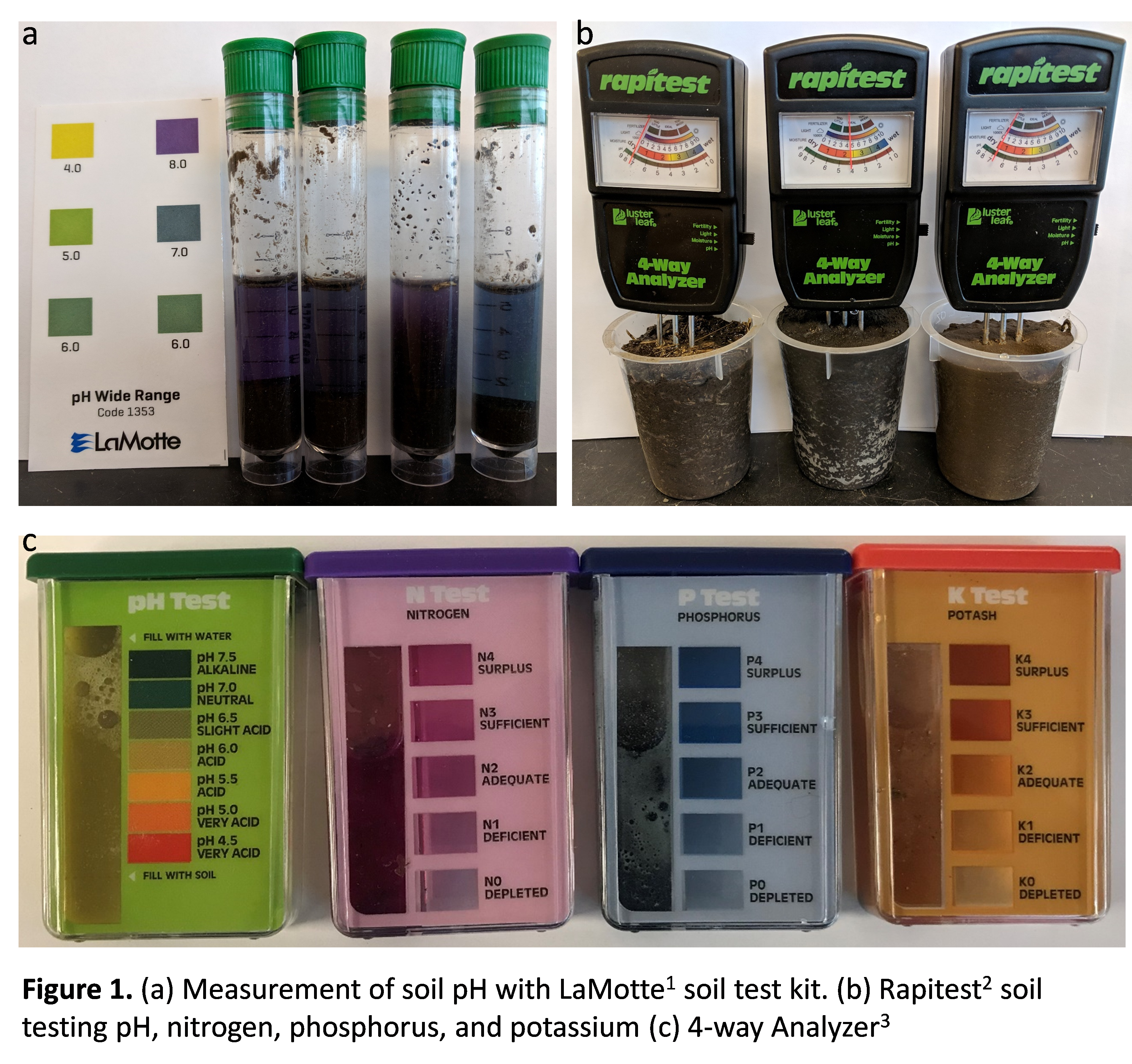
Results
The LaMotte pH, nitrate, and P soil tests were similar to the NDSU STL. The Rapitest soil pH and nitrate were similar to the NDSU STL results. The 4-way Analyzer soil tests were different from all NDSU STL soil tests.
Conclusions and Implications
- In some instances, the soil garden test kits provided similar soil test results to the NDSU STL. However, garden soil test kits tended to measure less nutrients than the certified soil testing lab
- North Dakota soils tend to have high levels of K. All garden soil test kits underestimated soil K levels.
- Using the garden soil test kits instead of a certified soil test lab may lead to over application of fertilizers, unless fertilizer recommendations are calibrated for the specific soil garden test kit.
- Several other garden soil test kits are available. Many of the untested kits have similar extraction solutions as the ones tested. If using an untested kit, the extraction solutions should be noted by the user to determine if the kit is comparable to a certified testing lab.
References
1LaMotte COMPANY. 2019. and LaMotte complete soil test kit. Chestertown, MD.
2Luster Leaf Products, Inc. 2019b. rapitest Soil Test Kit. Woodstock, IL.
3Luster Leaf Products, Inc. 2019a. rapitest 4-Way Analyzer. Woodstock, IL.
Jasper Teboh, Ph. D.
Jasper.Teboh@ndsu.edu
Research Soil Scientist
Acknowledgement
Authors: Chris Augustin, Jim Staricka, Ryan Buetow, Alicia Harstad, Jasper Teboh, and Beth Burdolski
Graduate Students Join the Carrington Research Extension Center
As a scientist, one of the most rewarding things I get to do is work with graduate students. Working with graduate students is fun and challenging; they keep you on your toes and make life entertaining. Some of the important portions of a graduate program are learning to run research projects and collect data, gaining experience with laboratory procedures, and learning to run statistics and writing research results. One of my observations over time has been that no two graduate students are the same and learning how to teach each one is an experiment in and of itself. Over the past few months we have had two individuals join us at the in the Animal Sciences program at the CREC.
Rebecca (Becca) Moore joined us in June as a graduate student. Becca is working towards her Masters in Animal Science while at NDSU. Originally from Raymond, Wisconsin, Becca graduated from the University of Wisconsin Platteville in May 2019. Becca’s research at the CREC is focused on the use of soybean hulls as a forage replacement in drylot cow rations. Becca will be working from the CREC until August 2020 at which time she will move to main campus to complete her course work.
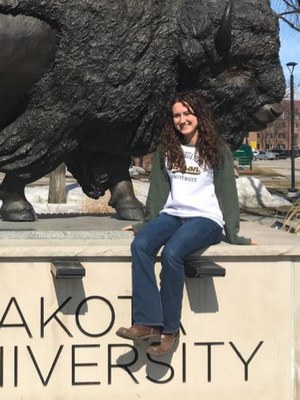
Becca Moore
Wayde Rodehorst joined us this past week as a Research Specialist/Animal Science. Wayde is originally from Columbus, Nebraska and is a May 2019 graduate of the University of Nebraska-Lincoln. While working as a Research Specialist, Wayde will also be pursuing her Master’s in Animal Science. As a Research Specialist, Wayde will assist with a number of research projects and work with the crew at the livestock unit to accomplish daily tasks with the livestock as well as oversee a number of research projects. Wayde’s primary interests for future research are related to Ruminant Nutrition.

Wayde Rodehorst
Anyone stopping by the CREC or attending Field Days will have the opportunity during the next few years to hear and learn about the research these two students have undertaken. We’re excited to have them onboard and look forward to making them a part of the team!
Bryan Neville
Bryan.Neville@ndsu.edu
Animal Scientist


